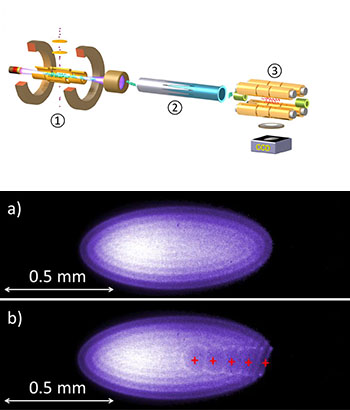
[Top] The experimental setup includes (1) an electron-beam ion trap for creation of highly charged Ar13+ ions; (2) a beamline for ion deceleration and pre-cooling; and (3) an ion trap containing the laser-cooled Be+ ions that sympathetically cool the argon ions. [Bottom] CCD images show (a) Coulomb crystal of around 1,500 laser-cooled, fluorescing Be+ ions in the ion trap; (b) the Coulomb crystal after implantation of five Ar13+ ions (position marked by red crosses). [Images: Max Planck Institute for Nuclear Physics]
Highly charged ions (HCIs) have tantalized scientists with the potential for exploring new frontiers in atomic-clock accuracy. But cooling HCIs, which begin life at temperatures of millions of degrees, to the near-absolute-zero zone required for atomic clocks has represented a huge obstacle on the path.
Now, scientists from Germany and Denmark have demonstrated a clever technique to trap HCIs and ratchet them down seven orders of magnitude in temperature, from the megakelvin to the millikelvin range, using “sympathetic cooling” by laser-chilled Be+ ions (Science, doi: 10.1126/science.aaa2960). The method could open up new realms for high-precision laser spectroscopy, and allow the development of optical clocks with accuracies ten times better than the best current models.
HCIs are attractive for high-accuracy optical clocks because they offer extremely high-frequency, narrow-linewidth electronic transitions to serve as timekeepers, with potentially low vulnerability to stability-sapping external perturbations. But they also resist the usual technique for chilling ions to superlow temperatures, direct laser cooling, because they lack appropriate transitions usually exploited in that technique.
The new setup—devised by scientists from the Max Planck Institute for Nuclear Physics and the Physikalisch-Technische Bundesanstalt, Germany, and Aarhus University, Denmark—cools HCIs through a different mechanism: using low-charge beryllium ions, on which laser cooling can work, to refrigerate the HCIs. In their setup, an electron-beam ion trap (EBIT) strips electrons off of argon atoms, creating a stream of Ar13+ ions at megakelvin temperatures. The bunches of HCIs, which leave the trap with kinetic energies in the keV range, next pass through a pulsed drift tube, where they are slowed down and pre-cooled.
The HCIs are then delicately deposited into a radio frequency ion trap containing Be+ ions that undergo laser cooling, to the point at which the beryllium ions form an ordered phase called a Coulomb crystal. Interaction between the HCIs and these super-cold Be+ ions ultimately reduces the HCIs to temperatures of less than 1 K—and, indeed, allows the highly charged argon ions themselves to become incorporated into the Coulomb crystal. The action was captured by a CCD camera, which read the fluorescent transitions of the Be+ ions during laser cooling and detected the entry of the non-fluorescing HCIs as dark patches.
The team was even able to establish the sympathetic cooling of a single Ar13+ ion by a single Be+ ion and their joint incorporation in a two-ion Coulomb crystal. That sets up the intriguing possibility of quantum logic spectroscopy—under which the HCI acts as the “spectroscopy ion” providing the high-precision optical transition, and the Be+ acts as a linked “logic ion” that handles the cooling and the fluorescent readout of the HCI’s quantum state. That, in turn, “paves the way,” according to the team, “for . . . optical clocks working at a projected 10−19 fractional accuracy level”—an order of magnitude better than the 10−18 accuracy of today’s best optical lattice clocks.
